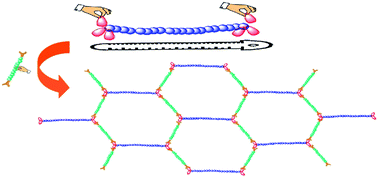Linear polystyrene (PS) with well-defined molecular structure and accurate numbers of bromo groups on both ends were synthesized via multiple-step alternative RAFT polymerization of N-bromopropyl maleimide and β-pinene monomers. The bromo end groups were transformed into the azido moieties via nucleophilic substitution. The reaction of as-synthesized linear PS having a named number of azide groups on ends ((N3)x–PS–(N3)x) with mono- and dialkynyl-terminated PEG (dA-PEG) via copper(I)-catalyzed azide–alkyne cycloaddition (CuAAC) leads to the formation of the well-defined PS–PEG amphiphilic copolymers and polymeric co-networks (APCNs). The as-prepared APCNs exhibit unique ordered separated hydrophilic and hydrophobic phases, and a variable swelling capacity both in polar and non-polar solvents.

